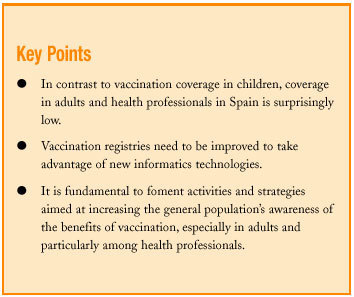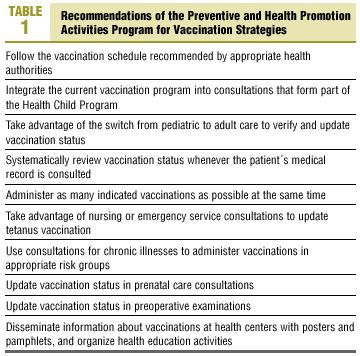There is no doubt that vaccination of the population against different infectious diseases is a highly useful preventive activity that affords maximal benefits. Influenza vaccination in adults has been widely shown to be effective in preventing flu and its complications, especially in older patients or those who are especially vulnerable because of underlying chronic disease. In contrast to vaccination in children, where coverage rates in Spain are considered among the highest in the world, vaccination rates in adults and among health professionals remain surprisingly low.
Simply reporting this fact is not enough; research is needed to investigate the possible causes and to design strategies aimed at improving vaccination coverage among
health professionals for whom it is indicated, and in the general population. In this connection the analysis by
Schwarz Chávarri et al1 of physician-related factors and the characteristics of the population of patients assigned to physicians is of considerable interest. The authors describe how these factors influence vaccination rates in the population of persons older than 65 years, in whom the indication for influenza vaccination is well established and for whom annual vaccination campaigns appear to be fully integrated into the activities of primary care health centers.
It is fundamental to foment all activities and strategies
aimed at increasing awareness of the benefits of vaccination in adults and children in the general public, and in health professionals. The efficacy of these measures and strategies to enhance vaccination coverage has been evaluated, notably in the extensive review published by the Task Force on Community Preventive Services of the Centers for Disease Control and Prevention.2,3 This publication evaluated the effectiveness of a number of strategies, based on computer, generated reminders or established protocols used at health centers, specially designed forms to record preventive activities in the patient´s medical record, pamphlets to remind patients about vaccinations (these measures share the drawback of being usable only for persons who visit health care facilities), retrospective and comparative studies of the levels of coverage attained by other professionals and other facilities, using house calls or visits for other motives to perform vaccinations, extending working hours or reducing administrative tasks to facilitate vaccination, or active outreach by contacting patients by telephone.
Other strategies have been suggested to increase vaccination rates in older people who have difficulties with access to health facilities. The activities shown to be most effective include active outreach with telephone or written reminders and computer-generated reminders to professionals, and comparative follow-up of coverage rates attained by different health centers. Strategies based on training for professionals have not been found to be very useful.4,5
Table 1 summarizes the general vaccination strategies recommended by the Preventive and Health Promotion Activities Program of the Spanish Society of Family and Community Medicine. The vaccination registry recently introduced in the health care system operating in the area studied by Schwarz Chávarri et al comprises a collection of fundamental, individualized documents that provide information on the user's vaccination status. This document is, in effect, an immunization biography that facilitates follow-up of all vaccinations regardless of where they are received (e.g., at work, a health center or a hospital). This system this will, it is hoped, prevent missed doses and overdoses, which are frequent for certain vaccines such as tetanus.
We should not overlook the opportunities for improving vaccination coverage provided by situations such as traveler counseling, health care for immigrants, and care for collectives such as penitentiary inmates or residents of detoxification facilities. The workplace, in particular, is a setting of key importance for health care workers.4
We should improve registry systems and the computer-based management of this information by taking advantage of new informatics technologies that facilitate the centralization of data on vaccinations. At the same time, we should ensure interoperability to be able to share information across different levels of health care. This would improve follow-up of the population and provide better information on the number of vaccinations administered, and thus provide an integral view of the user's vaccination status throughout his or her lifetime. In addition, this would la make it possible to detect potential groups of unvaccinated persons, and apply general or specific measures as needed to further increase coverage.6
These reasons make it important to give careful consideration to activities relating to vaccination in general, and vaccination in the primary care setting in particular. Such activities should aim to foment research and the development of truly effective strategies to improve coverage levels--especially in adults and health professionals--and to ensure that these activities are accurately recorded. Moreover, it is fundamental to actively seek out persons susceptible to disease for whom vaccination is especially indicated.











